In the first quarter of this year, public funds sent nearly 100 billion yuan of “red envelopes”. According to the data, as of March 31, 1461 funds (calculated separately for different shares) have received a total dividend of 94.320 billion yuan this year, including some “explosive” funds managed by well-known fund managers.
first quarter dividend 94.32 billion yuan
Data show that as of March 31, 1461 funds (calculated separately for different shares) had paid 1605 dividends in the first quarter of this year, with a total dividend of 94.320 billion yuan. It should be noted that among the funds that announce dividends in the first quarter of each year, the benchmark date of income distribution of some funds is at the end of the previous year, that is, the dividends of this fund belong to the dividends of 2021, but the dividends are paid in 2022. Therefore, such dividends are classified as 2022 during data statistics.
Compared with the total dividend of 88.633 billion yuan in the same period last year, the overall dividend of public funds increased by 6.42% in the first quarter of this year. Among them, the total dividends of equity funds and hybrid funds were 54.155 billion yuan, accounting for 57.42% of the total dividends of public funds.
Specifically, in January this year, there were 555 public funds with a total dividend of 41.404 billion yuan. In February, affected by the Spring Festival holiday, 185 funds paid dividends, with a total dividend of 10.97 billion yuan. In March, the number of dividend funds increased significantly compared with the previous two months, reaching 833, and the total dividend was basically the same as that in January, reaching 41.946 billion yuan.
From the perspective of dividend amount, GF Small Cap Growth A has the highest total dividend, with a dividend of 3.096 billion yuan in the first quarter. The A of Baijiu was followed by the 2 billion 890 million yuan in the first quarter. A total of 16 funds paid dividends of more than 1 billion yuan in the first quarter, and 36 funds paid dividends of more than 500 million yuan in the first quarter.
In terms of the number of dividends, Baoying’s core advantage has the most dividends, and the A and C shares were red for 9 times in the first quarter of this year. E-fund value selected dividends for 4 times, and 13 funds such as e-fund strategy No. 2 and southern diversified fixed development all paid dividends for 3 times.
“hot money” fund large dividend
In the dividend army, there is no lack of some well-known fund managers to manage the “hot money” funds to pay large dividends.
On March 25, GF small cap growth a managed by Liu Gesong announced a dividend, with a total dividend of 3.096 billion yuan. The benchmark date of the income distribution of the fund is December 31, 2021, which is the first dividend in 2021, and the cash dividend payment date is March 31, 2022. In 2020, the fund increased by 74.32%, and in 2021, the fund also reaped a positive return of 1.86%.
Hou Hao managed A Baijiu liquor, which has been announced for 2 billion 890 million yuan. The cash dividend payment date is January 5, 2022, and the base date of income distribution is December 24, 2021. In addition, e fund value selection managed by GE Qiushi paid dividends four times in the first quarter of this year, with a total dividend of 2.793 billion yuan; Ten thousand industries managed by Huang Xingliang preferred a dividend of 1.922 billion yuan in the first quarter of this year.
Although many Jimin believe that the fund dividend is left-handed and right-handed, there are many considerations about the fund dividend in the volatile market. Insiders said that first of all, dividends in the shock city can share the investment results with the foundation people and give the foundation people confidence; Secondly, large-scale funds can reduce the management scale and the risk of fund positions through large-scale dividends in the volatile market; Finally, a large number of dividends can reduce the pressure of centralized redemption of the fund, and some companies hope to reduce the net value through dividends, so as to attract more funds.
